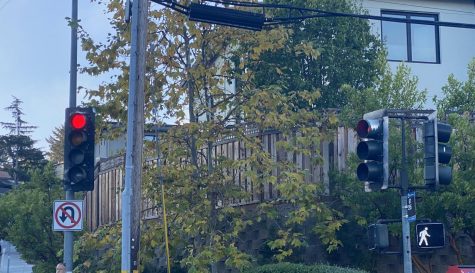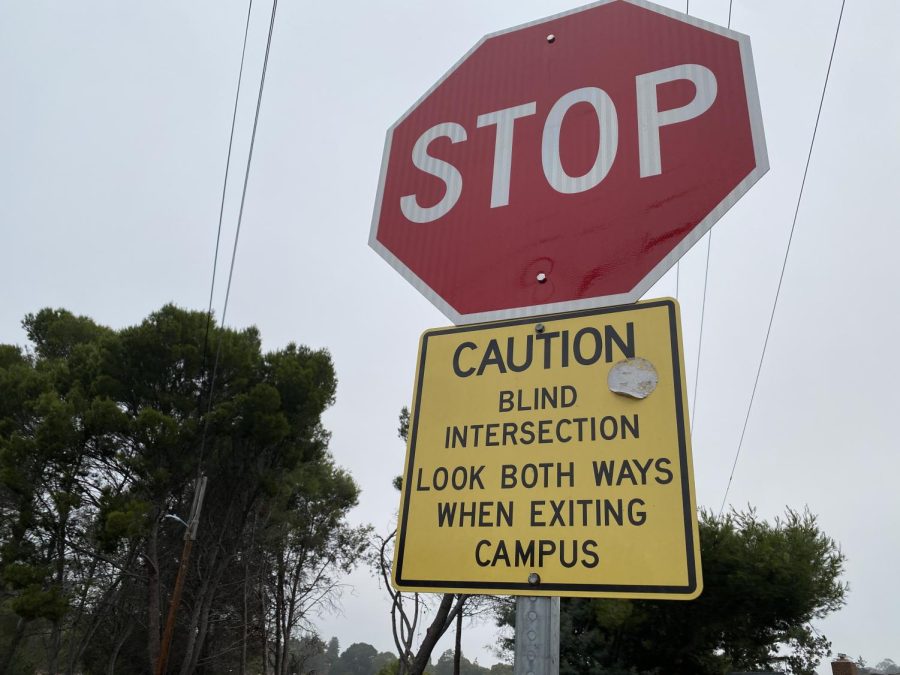The city of Belmont has implemented lead pedestrian intervals near campus to increase pedestrian safety during peak school traffic hours. However, the Carlmont community’s traffic struggle hasn’t disappeared overnight.
A lead pedestrian interval (LPI) is when pedestrians are given the signal to cross an intersection five seconds before the light turns green for vehicular traffic.
“It puts the pedestrian out in front, highly visible, and gives them a little bit more time to start crossing the intersection. LPIs are an important safety enhancement that can be deployed at select traffic signal intersections,” said Jared Barrilleaux, the assistant director of public works for the city of Belmont.
LPIs are intended to increase pedestrian visibility and safety. However, they can also have the opposite effect. At some intersections, drivers are waiting to turn right at a red light and aren’t always aware that pedestrians can have the walk signal while vehicles have a red light. This can lead to near misses at particularly hectic intersections.

“Some intersections lend themselves to LPIs better than others, so it is something that needs to be reviewed by a traffic engineer to determine the benefits of implementing an LPI at a given intersection,” Barrilleaux said.
However, students are largely unaware of these LPIs, with multiple students surveyed saying they haven’t noticed the feature. These LPIs also do nothing to address the parking lot entrances — a major source of congestion.
While safety is the most important aspect of traffic at Carlmont, the congestion is also a huge inconvenience for students and staff alike. Many get to school early simply to avoid congestion.
“I get here at 5:30 a.m. just so I don’t have to deal with the traffic,” said David Heck, a Carlmont P.E. teacher.
The city has a project underway to create roundabouts to minimize congestion. However, the project isn’t due to be completed until 2025, and they have no plans to mitigate the traffic in the meantime.
While Barrilleaux recommends taking public transportation, that isn’t an ideal solution either. Buses are overcrowded and not always convenient, particularly with the removal of route 95. It will take time for SamTrans to find and create ideal bus lines, but they are actively troubleshooting.
“Getting rid of the 95 was a mistake,” said Grahm Schwaderer, a sophomore at Carlmont.
Schwaderer is a public transportation enthusiast and a former intern with Kevin Mullin, the district’s state representative, where he was involved in traffic safety planning.
The crowding and minimal bus routes push students to take private vehicles to school, intensifying the congestion. This includes student drivers who are new to navigating complicated traffic situations.
“I’ve witnessed a lot of close calls. I’ve been part of a lot of close calls. The pedestrians and student drivers don’t mix well,” Schwaderer said.
The hectic daily commute has been worsened by the unified start time the district created as a result of California Senate Bill 328, requiring high schools to start no earlier than 8:30 a.m. While the bill is aimed at improving student sleep deprivation, the traffic has eliminated the potential benefits for many.
“I get up at the same time, maybe 20 minutes later, but it’s not enough. It’s not worth it,” said junior Elena Bilello, a student driver. “I live five minutes from school, but I have to leave 40 minutes early to make sure that I can get there.”
Bilello also spoke about the stressful safety aspect of the daily commute.
“We’re new drivers, and we’re still getting the hang of the exceptions of driving. They’re not exactly the rules, but they’re things we have to do to get through the traffic,” Bilello said.
Schwaderer also emphasized the confusing environment the morning and afternoon traffic creates.
“No one knows when to go. Someone will pull into the crosswalk but then will stop because of a pedestrian — it’s just a huge mess,” Schwaderer said.
Students are stressed and concerned about the traffic that they encounter daily, with anonymously surveyed students commenting that “it’s almost a free-for-all.”
With no obvious alternatives or solutions, Schwaderer urges students and parents to be aware of their surroundings and to try to approach the situation calmly.
“Students don’t know when to cross the street or will cross without looking. Be aware, and don’t let the stress overwhelm you,” Schwaderer said.













Jenna • Oct 15, 2022 at 5:12 pm
The removal of route 260 also contributes to this! Some of us take the 62 but it rarely gets there on time in the mornings, and that’s super annoying. Honestly, the new times and bus changes just made everything worse.